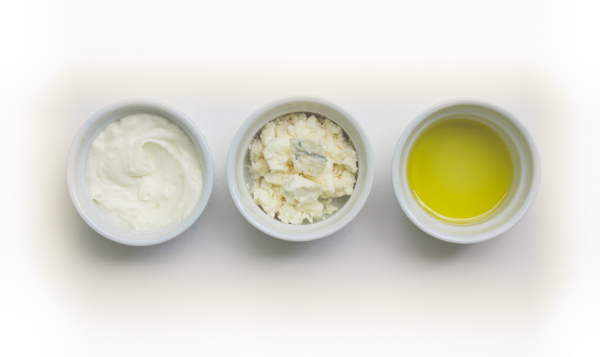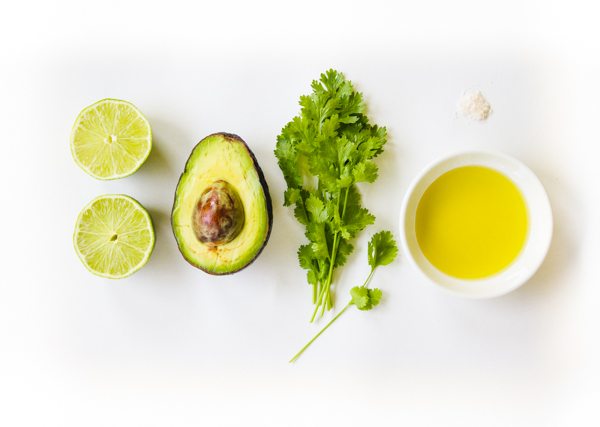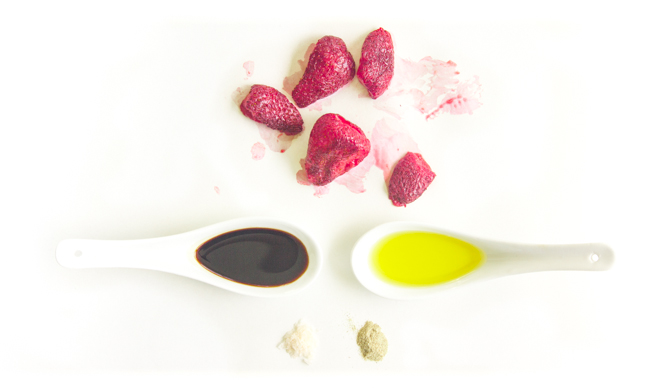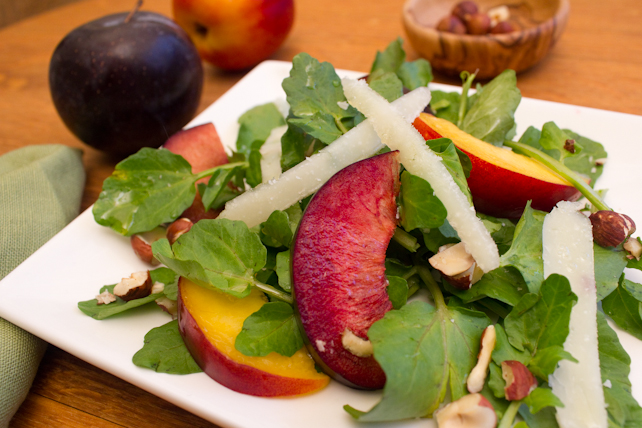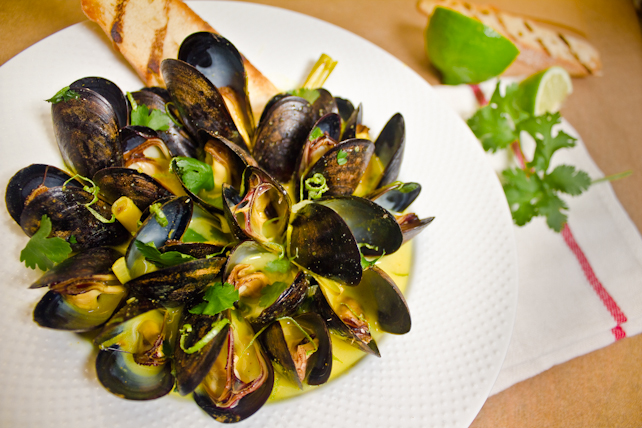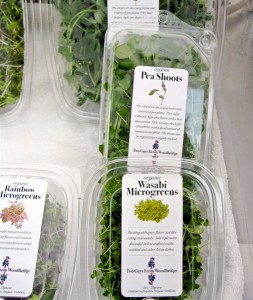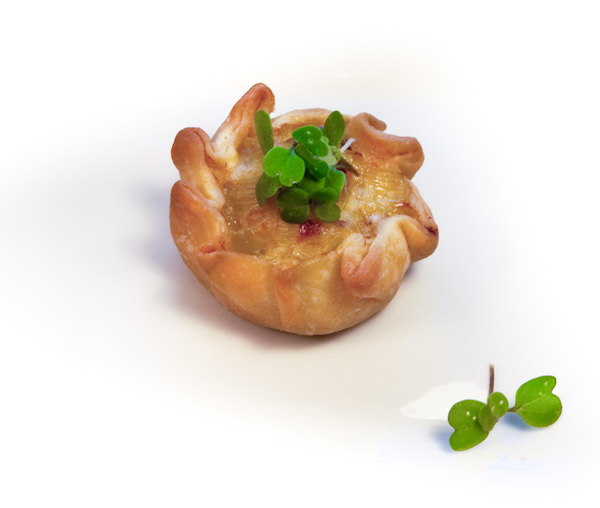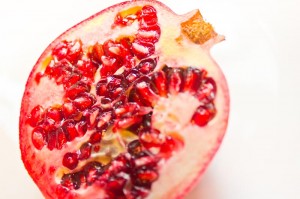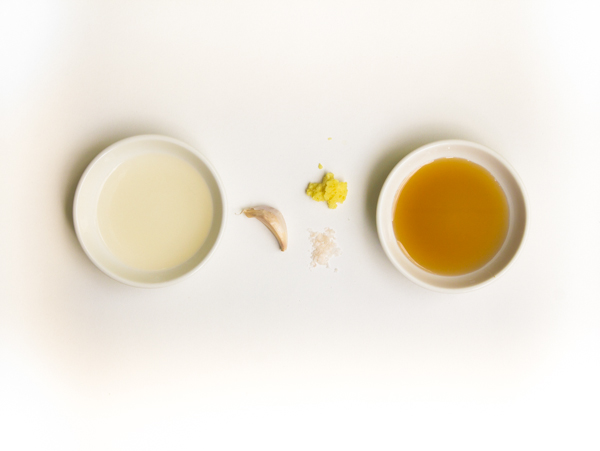 I love this dressing and use it all year long--but particularly in the summer over a bowl of fresh sliced cucumbers, or a batch of quick-blanched fresh broccoli or green beans, or sauteed greens, all from the garden. I love this dressing and use it all year long--but particularly in the summer over a bowl of fresh sliced cucumbers, or a batch of quick-blanched fresh broccoli or green beans, or sauteed greens, all from the garden.Toasted sesame oil, one of my most favorite pantry staples ever, is widely available, but if you pick it up in an asian market or anywhere in Chinatown, it will be dollars cheaper per bottle.
| ||||||||||||||||||||||
I made this quickly in the blender this week, to go over a cold rice salad with shredded poached chicken, local corn, a few early tomatoes and chunks of avocado. Mostly the goal was to distribute the little bit of avocado I had on hand as much as possible throughout the salad. We loved the result, and I expect we'll be drizzling this all over salads, soups, sandwiches, and all sorts of grilled things all summer long. Creamy Avocado Lime and Cilantro Dressing By Catie Baumer Schwalb makes about one cup. 1/2 avocado 3 tablespoons fresh lime juice, from one large lime, or a few smaller 1/4 cup, packed, fresh cilantro (include stems too if they are young and fresh) 1/2-3/4 cup olive oil salt, to taste In a blender, combine avocado, lime juice and cilantro. Blend until smooth. Through the hole in the blender lid, slowly pour in the olive oil, with the blender on low. Start with a half cup, and taste for balance. If it seems too tart, add a little more gradually, tasting as you go. Season with salt, to taste. Serve immediately, or chill briefly. | ||||||||||||||||
Make this right now, with all those plump ephemeral strawberries lurking around. (If you are making this out of season--gasp--consider adding a small pinch of sugar to the berry puree to help boost the flavorless winter berries). If you can make it past eating it directly from the mixing bowl, serve this dressing over a spinach salad with toasted pecans or walnuts and some crumbly goat cheese. Or dip some grilled chicken into it. Or grilled pork. Or duck. Or heck, put that on the salad too. Oh, and do yourself a favor: get some really good balsamic vinegar.
| ||||||||||||||||||||||
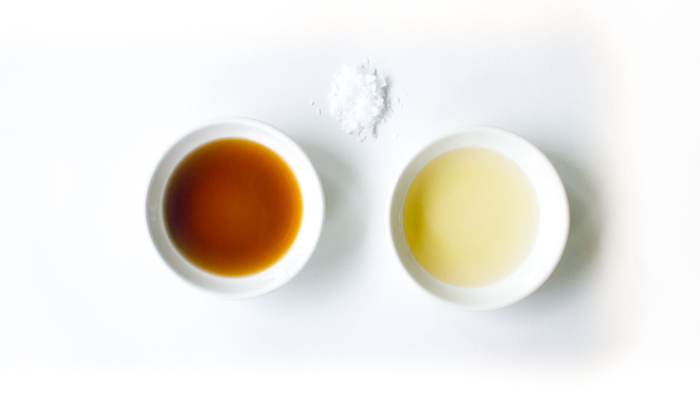 Last night I was having dinner with some of my favorite lady friends, and we were talking about salad dressings, as you do with your lady friends. They were saying that they each always make their same standby dressing, and were enjoying this new blog feature to help get out of their ruts. We shared what each of our quick, don't have to think about it, dressing recipes are, and I had forgotten that for the longest time this one was mine. The mellow rounded sweetness of the sherry vinegar and the rich roasted nuttiness of the hazelnut oil are a combination that is tough to beat. It also makes one of my favorite birthday or hostess gifts. A bottle of each, and perhaps some great salad servers, have yet to make anyone unhappy. Use this dressing as an excuse to use up any hazelnuts that are left over in your pantry from some long-forgotten holiday cookie recipe. I love subtly mirroring the dressing in the salad ingredients.
| ||||||||||||||||||||||
I love rhubarb. I love it for it's old fashioned vibe. I love it for it's color, striking tartness, and even for it's moderate shelf life. I also love it for showing up so darn early in the spring and sticking around for several months. And I too was at first intimidated by those long, irregular-shaped, tough magenta stalks at the market. I actually overheard a conversation at our market up here recently, where a woman who had just bought a weekend house near the Delaware discovered she had huge decades-old rhubarb plants growing on her property. However she didn't know when it was time to pick them. Nor did the young woman working the farm stand, so I jumped in with what I knew. She had been waiting for them to turn red, ripen, to pick. I explained that some heirloom varieties, have very little red, and the stalks can range from thin to the thicker more uniform we're used to seeing in grocery stores. I generally go by feel, but you can harvest stalks when between ten and fifteen inches long, avoiding letting them go too long and become tough, dry or woody. Once you get your rhubarb back you your kitchen, from yard or market, they really are one of the most simple fruit to prepare. Make sure all traces of the leaves are trimmed off, as they are not edible. Rhubarb have a bad rap for being stringy, as in celery stringy, but as long as they are cut in small pieces before cooked, the strings will not be a nuisance. For good measure, or habit, I tend to peel two or three strings off each stalk, from end to end, but not too much, as you are also peeling off any of the great magenta color. Wash the stalks well and then cut into slices between an half inch and an inch thick. You can then roast the pieces, throw them in to brighten up a rich stew, or as I do most often, simmer them down to a quick rhubarb puree or sauce. Pack the rhubarb into a sauce pan or small pot that holds the pieces sort of snugly. Add enough water to come up about 3/4 of the way up the sides of the slices, and simmer over a medium-low heat, until the rhubarb has broken down and is tender. Add more water if the mixture seems to be getting to dry or risking burning at all. When finished you can mash it up a little to have a sauce with more texture, or use a food processor, blender or immersion blender to give you smoother final product. If you are looking to use the sauce as a topping by itself, add about a tablespoon of sugar per large stalk of rhubarb when simmering down, or another classic way to cut rhubarb's intense sourness is to add at least 1 part strawberries for every 3 parts rhubarb when starting the sauce. Taste when finished and adjust sweetness if necessary. Vanilla beans, ginger, orange, cinnamon, almost all berries and apples are all great additions as well. Make a big batch. Eat it warm or ice cold. Spoon it over ice cream, blend it into cream cheese, swirl it in yogurt or oatmeal, drizzle it over a wedge of Stilton or duck or game meats, whisk it into your vinaigrette, blend it with ice for your margarita. Really, what other fruit, the northeast no less, is quite so versatile? | ||||||||||||||||
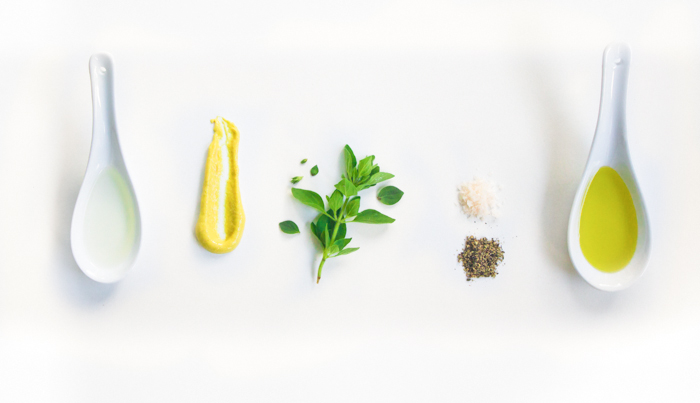 For another step in my continued fight to close down the salad dressing aisle in grocery stores, I'll offer you a homemade salad dressing recipe each week. Fresh oregano certainly has a pronounced flavor, but actually so much more mellow and herbal and complex than what dried drab green flecks and pizza restaurant shakers have lead you to believe. We had this dressing last night on crisp fresh red leaf romaine, a small handful of fresh sorrel leaves (both sliced into ribbons, both from our garden), cucumber, and a generous handful of toasted sesame seeds. This vinaigrette would also be incredible on a salad of baby spinach, chickpeas and sliced hardboiled egg, or as a base for a potato salad. Also, P.S., oregano is probably the most idiot-proof herb to grow, super hearty, pops up first in the spring and faithfully returns each year. Grab a plant and stick it almost anywhere in your yard now for years of salad dressings and marinaras to come.
| ||||||||||||||||||||||
Last month I was asked to be one of the Foodie 100 on the new Foodie.com beta site. It is a very pretty, very full, social network-y site with, among others, 100 great food writers and bloggers as contributors. I have three recipes on the site now, that I created just for them. Check them out and take a look around. There is a lot of really delicious stuff going on there.
| ||||||||||||||||
I just discovered the Telepan TV channel on youtube. Bill Telepan is one of my most favorite NYC chefs, who I had the great, great pleasure of cooking with for many months that the start of his inspirational and important Wellness in the Schools school lunch campaign. He has started to put together videos, sharing some of his incredible recipes from his incredible restaurant Telepan. The three recipes using cherry tomatoes in the video above are making me very. very. hungry. Run! and get some cherry tomatoes at the markets this weekend while they are still available (we had a frost at our house last night!). | ||||||||||||||||
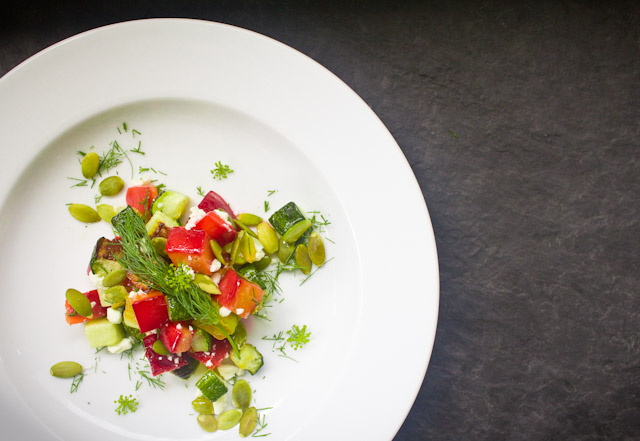 Here is a quick recipe I dreamt up, while on my roasted produce kick this week, using what is in abundance in the gardens and at the market. Thankfully, it turned out to be heavenly, lick-the-bowl-clean good. There is a magical, sum is definitely greater than it's parts, result here, as with many very simple summer dishes (think: Tomatoes+Basil+Olive Oil.). Sweet and sour and earthy and salty and bright and crunchy all going on in your mouth together. Roasting the nectarines and zucchini really intensifies their flavor and makes them both feel like vegetables...or fruit...or something new and unique completely. A beautiful side dish for any summer meal, I imagine this would also be spectacular atop grilled fish, pork, or chicken.
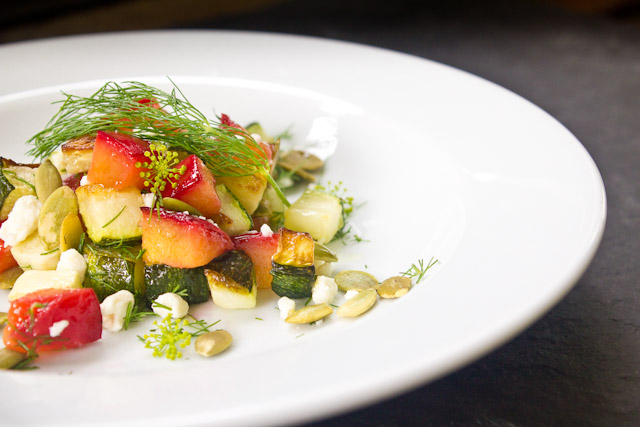 | ||||||||||||||||||||||
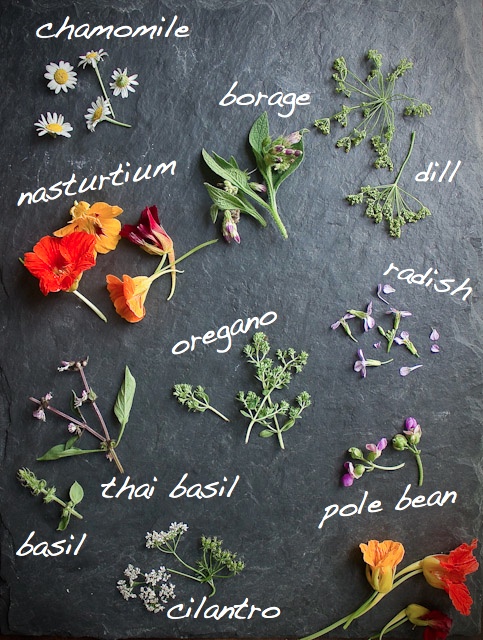 These weeks the gardens are bursting with flowers. Not the flower gardens, but the herb and vegetable gardens. Some of the flowers I planned on (nasturtiums and chamomile), some are part of the journey (pole bean blossoms which will become bean pods), and some are a result of me not harvesting fast enough and a bit of the plant going to seed (cilantro, basil, dill, oregano, and radish). I'm a big proponent of using as much of a plant or vegetable as I can. One of my favorite "tip to toe" recipes doing this is Chef Bill Telepan's Beet Greens Pierogi with Mixed Summer Beets and Brown Butter Sauce. I also got much too excited when I learned in a master class in culinary school, with chef Michael Anthony of NYC's Gramercy Tavern, that I could pickle the technicolored chard stems I had been pushing aside and composting for years. It is equally exciting for me to use flowers in dishes. As mentioned, some are planned, some are not, but there is a lot of flavor, and a ton of color and texture there that would otherwise go to waste. They are not just a pretty face--and frequently fetch a premium price at the markets. Certainly make sure you know what you are serving and eating, so as not to go all Arsenic and Old Lace on unsuspecting BBQ guests. But there are so many varieties of edibles around right now, and just a small edition of a few feels very very special. Cleaning and Storage Try to pick the flowers as close to use as possible. Store them, unwashed, wrapped gently in paper towel in the refrigerator, protected in a bowl or open container. Teeny tiny bugs love to hide out in their petals and folds, so examine each blossom carefully. To wash, and to refresh flowers that are a little droopy, plunge the entire blossom in a bowl of cold water for about five minutes, and then allow to dry on a paper towel. After washing, flowers can be floated. right side up, in a bowl of cold water until ready to go onto the plate. Ideas for Use - Salads! Whole or torn, little bursts of blossom color are a magnificent addition to salads. Nasturtiums in particular, leaves and flowers, with a wonderful peppery zing, are a great addition. But also think about the flowers of complimentary herbs like dill, basil, cilantro, and chervil. Then consider adding some of the same herb to the dressing to tie it all together. - Garnish soups by floating a single blossom in the middle of the bowl. This is particularly effective with cold soups, as it won't wilt the flower. Try it with Borage, a beautiful purple flower with a taste very similar to fresh cucumber. - Decorate cakes, cupcakes and pastry with a blossom here and there. Edible flowers definitely each have their own flavor, so stick with the sweeter and more floral plants for this, like chamomile, lavender, and mint. - Tear up some petals and sprinkle them over a plate or platter like confetti right before serving. Or make a tiny micro salad of flowers to top a piece of grilled fish or meat.  A quick snapshot from lunch--Buttermilk with Fuji Apple Dashi, Market Herbs and Flowers, and Pine Nuts at Momofuku Ssäm Bar, NYC. | ||||||||||||||||
This remarkably quick meal is a colorful and crunchy way to use the insanely good soft shell crabs that are coming into season right now. I made this for my husband and I a few nights ago, and was so pleased with the speed to wow ratio. But in addition it was so so so good that we craved the exact same thing for dinner the following night with the extra crabs I bought to photograph for the blog. Though the crabs need to be served immediately after pan-frying, they take just minutes, and so still could be a great alternative for a small group BBQ, turning out crabs as you would burgers off the grill. You can also skip the rolls and just serve them atop a salad of greens and slaw. I also highly recommend trying the same recipe using thick green tomato slices in place of the crabs later in the summer. Oh, how I love cooking during these months... (more…) | ||||||||||||||||
Here's a great little dish using those irresistable watermelon radishes and microgreens now growing at a farmers' market near you. Ready in under a half hour, this would be a deceptively easy, super impressive first course for a local-chic dinner soiree. Or triple the scallops, and pair it with cool buckwheat soba noodles dressed with sesame vinaigrette and sprinkled with additional microgreens for a light and springy main course. Either way it uses some of the best items our farmers are offering up at this moment. And after months and months of braised root vegetables, some very welcome fresh leafy crunchy variety.
[caption id="attachment_2004" align="aligncenter" width="600"] 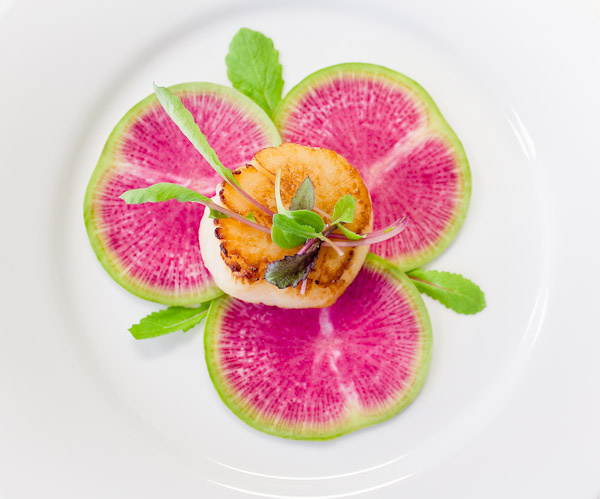 http://www.pitchforkdiaries.com/2011/03/25/pan-seared-sea…crogreen-salad/[/caption] http://www.pitchforkdiaries.com/2011/03/25/pan-seared-sea…crogreen-salad/[/caption] | ||||||||||||||||||||||
 Micro Mesclun from Windfall Farms, Union Square Greenmarket, NYC. Spring is here, and the farmers' market offerings are slowly transitioning from squash, root vegetables, and cold storage foods to fresh spring produce in the weeks ahead. One of the first fresh spring finds to look for are microgreens.
Arugula, lettuces, beets, radish, and kale are very commonly used for microgreens, but cilantro, basil and wasabi are available for a really exciting addition. They are used frequently as a fancy-schmancy garnish in restaurants, offering great color and texture, in addition to a burst of flavor on the top of a dish. But use them at home for a delicate little salad, to top off a piece of grilled seafood, or anywhere you want to add a small bit of freshness without overpowering a recipe with large greens leaves. They are thin and delicate, so are perfectly tender just eaten raw. Keep an eye out for them at the market, or grow your own in some seed flats in your window until the weather gets a little warmer, and then set aside a micro-patch of garden for the rest of the season. Ready in just over a week, I've planned ahead for dinner parties, planting seeds a week or so prior, and snipping fancy-schmancy garnishes of my own hours before my guests arrive. Impressive? Yes. Easy? Yes. Flavorful, healthy, and fun on plate? Yes, yes and more yes. Gruyere and leek tartlette with homegrown arugula microgreens. | ||||||||||||||||
It was announced yesterday that Mark Bittman's weekly column in the New York Times will end its thirteen year delicious, informative, enthusiastic, and encouraging run.
http://www.youtube.com/watch?v=kqChHSsf42c I have learned many lessons from Mr. Bittman's column. Starting in 1997, a year after I graduated from college, I cooked recipe after recipe from his writing and suggestions and road maps of seasonal dishes. His overarching philosophy of don't be intimidated, just get in the kitchen and make good, real food--"It's not rocket science"--is the cornerstone of what I deem most important in the work I do and what I am most trying to impart in this blog. His article The Well-Dressed Salad Wears Only Homemade in 2006, not only instantly convinced me to remove all store-bought salad dressing from my life, but also started my path of questioning any and all store bought food-stuffs. He sent my husband and I on a scavenger hunt through winding cobblestoned back streets of Genoa, Italy, and putting Genoa on our itinerary at all, because of his completely intriguing description of the hole-in-the wall greasy spoon, Trattoria Maria, as "one of my favorite restaurants in the world." It ended up being our favorite city of the trip---the trip on which we got engaged. His coverage of Jim Lahey's no-knead bread technique, sent me, and throngs of other eager cooks, out in search of hearty lidded cast iron cookware (according to the sales person at the Le Creuset outlet in Woodbury Commons: "Are you here because of The Bread?"), and got the country excited about making homemade bread. I encourage you to go back over his fun, relaxed and heartfelt collection of pieces, and cookbooks (How to Cook Everything, 2,000 Simple Recipes for Great Food Thank you, Mr. Bittman. Looking forward to what's next on the menu. A few of my favorites from the past years, that I return to again and again: Soto Ayam--Indonesian Chicken Soup with Noodles and Aromatics Chard Stuffed with Lemon Saffron Risotto and Mozzarella Chicken Biriyani 101 Simple Salads for the Season 101 Simple Appetizers in 20 Minutes or Less Almond-Apricot Granola Bars | ||||||||||||||||
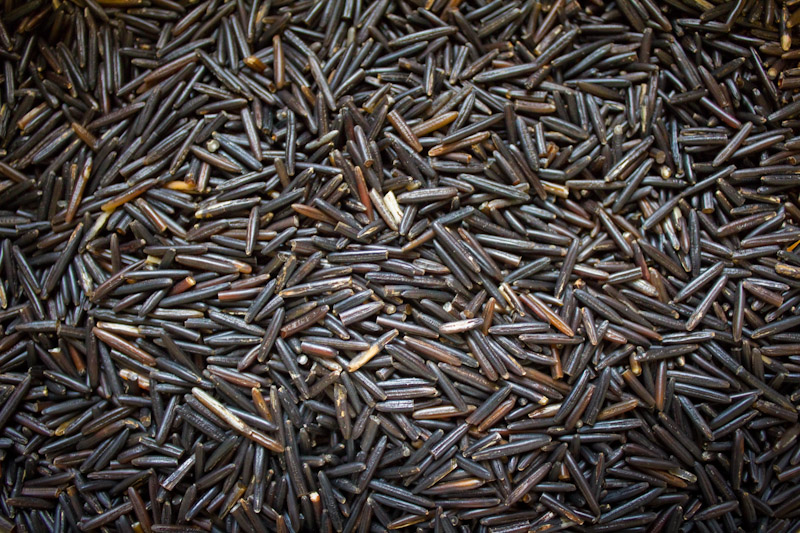 My friend, and great cook, Cathy Elton asked me to contribute to a thanksgiving recipe series on her heart-healthy blog "What Would Cathy Eat?". One recipe she requested was a "stuffing made without meat or butter". Not an intuitive leap for this French Culinary Institute-trained, duck-fat-loving chef. I started musing on wild rice. Deeply flavored, elegant, and a little unexpected, it is also a really smart choice in the middle of a seemingly endless table of fatty simple carbohydrates. This nutty whole grain is actually not technically rice, but rather a seed from the aquatic grasses surrounding fresh water lakes in northern North America. It has twice the protein of brown rice, and almost eight times the protein of white, serving up 6.5 grams in one cooked cup, with 3 grams of fiber. There is a rich mysterious aroma to the grains, reminiscent of tannins and black tea. I added tart dried cranberries and apricots, woken up with some light vinegar, which will offset the richness of turkey and gravy. This dish would also be wonderful for lunch the next day, as a cold rice salad with leftover pieces of turkey added, or made with chicken any time during the year. And with this smart side dish choice, just think of all the extra pie you can justify.
 | ||||||||||||||||||||||
 My dear friend from graduate school, January LaVoy, just opened her luminous performance in Arthur Kopit's Wings, off-Broadway at the Second Stage Theater this past weekend. When I had the chance to see the show, I thought, "Anyone can bring flowers...I'll lug down a just-picked squash from our garden." I mean, who wouldn't want to be greeted with that in the lobby??? (and have to deal with it on the subway home?) 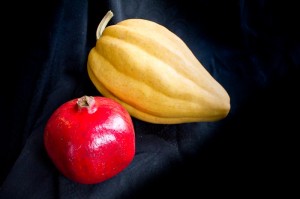 This particular winter squash is an heirloom variety, called Thelma Sanders Sweet Potato Squash. I bought these seeds specifically because it was described by Seed Savers' Exchange as their "favorite two-serving baking squash". I envisioned romantic squash dates all winter long. It is pale orange like a butternut, but tear-shaped and ribbed like an acorn. It has a creamy, golden flesh, that works in recipes for either variety. So, as promised, here is a recipe of something to do with said squash, especially for our big star. And Wings runs through November 21st. If you are in NYC, don't miss this one.
 | ||||||||||||||||||||||
Though apples are excellent long-keepers, and will be around for months at the markets, they never taste better to me than right now--sun still warm in the sky, "transition" jacket getting pulled out of the closet, leaves crunching beneath my feet, and halloween fast approaching.
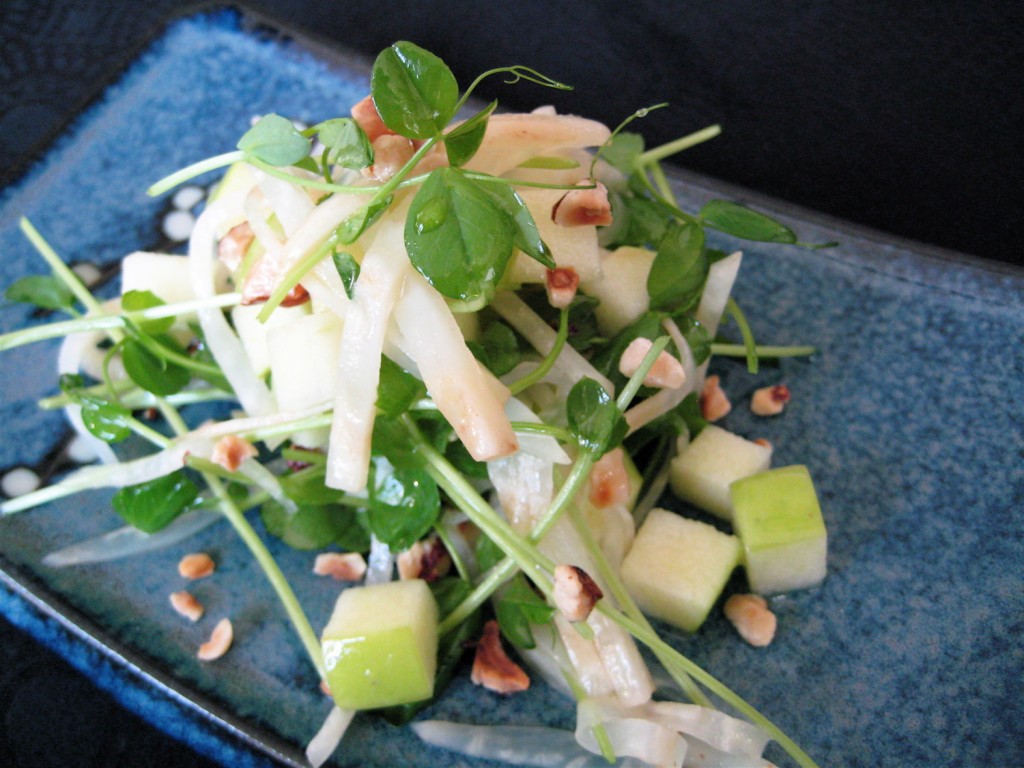 Grab a few extra apples at the farmers' market this week, and try this salad I posted in the early spring. Pea shoots might still be available, but if not, late season salad greens, particularly arugula, would be a great addition. Pea Shoot, Celeriac, Apple and Hazelnut Salad | ||||||||||||||||
As a follow-up to my previous post about all things salad dressings, here is a recipe for another rock-star of a vinaigrette, following the same formula: 1 part acid + 3 parts oil + seasonings and flavoring ingredients.
This is dynamite tossed with fresh blanched local beans, perhaps adding soba noodles for downright craveable homemade sesame noodles. But it is also wonderful as a marinade for grilled chicken, beef, or pork, with the acid of the vinegar bringing the added bonus of a great meat tenderizer.  SESAME GINGER VINAIGRETTE RECIPE By Catie Makes approximately ¼ cup Rice Vinegar, 1 TBS Garlic, ½ clove, crushed and finely chopped Fresh Ginger, ½ tsp, grated Toasted Sesame Oil, 3 TBS Salt, to taste Combine the vinegar, garlic and ginger in a bowl, and allow to sit for 10 minutes, to infuse the vinegar with the flavor of the garlic and ginger. Then, while whisking constantly, pour the sesame oil into the bowl in a slow, thin stream. Taste, and adjust salt. Serve as a dressing for a green salad, tossed with cooked vegetables (green beans, broccoli, carrots, sautéed greens) or as a marinade for grilled meats. SESAME GREEN BEANS RECIPE Blanch green beans, by cooking in a pot of boiling, heavily salted, water for a few minutes, until crisp-tender. Immediately remove with a slotted spoon to a bowl of ice water to shock to stop the cooking. Drain and pat dry. Toss with Sesame Ginger Vinaigrette and toasted sesame seeds. Can combine with noodles, like Japanese buckwheat Soba noodles, for a more substantial dish. Top with slivered scallions and toasted sesame seeds. | ||||||||||||||||
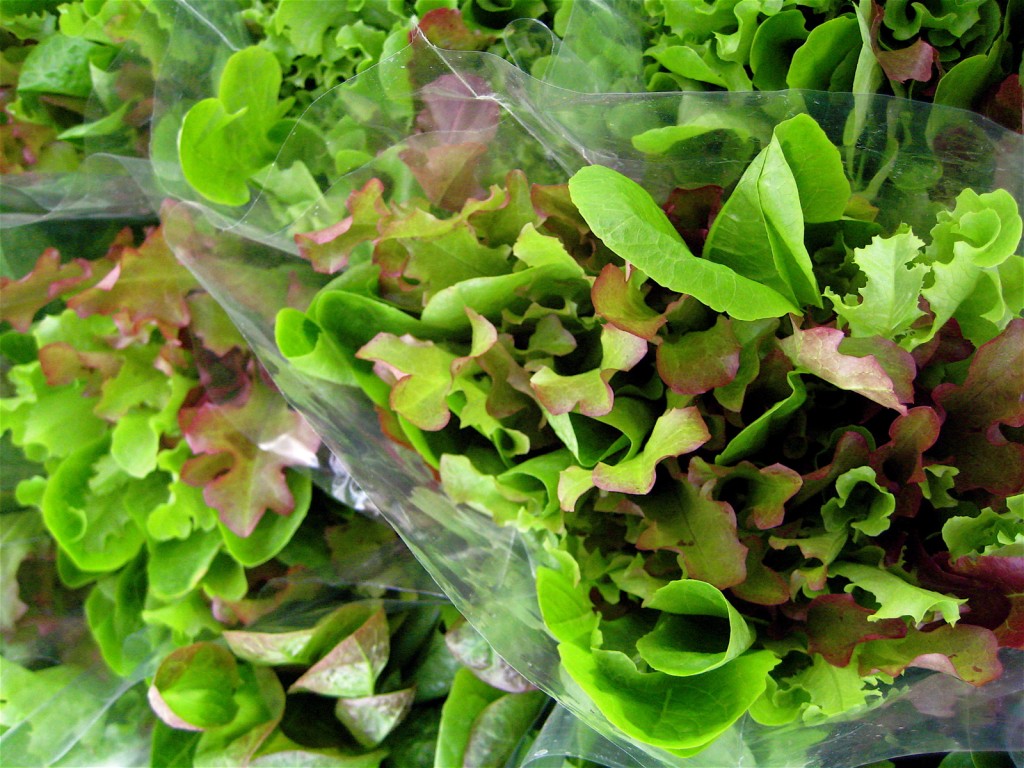 Just about four years ago, Mark Bittman wrote a great piece in the New York Times; A Well-Dressed Salad Wears Only Homemade, and it got me thinkin'. Why did salad dressings feel like such a mystery? Why is there usually a huge amount of grocery store real estate devoted to them? Why are they so darn expensive? A recent peek at dressings in my grocery store upstate, showed even the cheapest dressings at around $2.50 for an 8 oz bottle, jumping to $3.59 a bottle for something just slightly more natural. That's $40-57 a gallon--compare that to something like the price at the pump, and it feels like complete lunacy. The other glaring issue I noticed was that sugar, often in the form of high fructose corn syrup, and WATER, frequently make up two of the first three ingredients. Again, lunacy.  A few weeks ago I did a cooking demonstration at a local harvest festival. Showcasing the gorgeous local produce (supplied by Beaver Dam Brook Farm in Ferndale, NY), I did a brief primer on dressings and vinaigrettes. As I was myself when I first started cooking, many of the audience members at my cooking demos were surprised at how fast and simple it was to make a vinaigrette. And so much less expensive while eliminating chemicals, emulsifiers, and that big dose of unnecessary sugar. It seemed crazy that there we were, at a huge farmers' market, a group of people devoted to buying the freshest, least traveled, produce, and yet were not thinking much about then topping that produce with something that was possibly over a year old (when purchased, not to mention the time it has sat on that narrow shelf on the door of your refrigerator), gooey, syrupy, and most likely swimming with ingredients from a factory and not a farm. A few weeks ago I did a cooking demonstration at a local harvest festival. Showcasing the gorgeous local produce (supplied by Beaver Dam Brook Farm in Ferndale, NY), I did a brief primer on dressings and vinaigrettes. As I was myself when I first started cooking, many of the audience members at my cooking demos were surprised at how fast and simple it was to make a vinaigrette. And so much less expensive while eliminating chemicals, emulsifiers, and that big dose of unnecessary sugar. It seemed crazy that there we were, at a huge farmers' market, a group of people devoted to buying the freshest, least traveled, produce, and yet were not thinking much about then topping that produce with something that was possibly over a year old (when purchased, not to mention the time it has sat on that narrow shelf on the door of your refrigerator), gooey, syrupy, and most likely swimming with ingredients from a factory and not a farm.So here's the basic formula: 1 part acid + about 3 parts oil + seasonings and flavoring agents Put the acid in a bowl with the seasonings and flavoring ingredients, if using. If you have time, allow that to sit for 5-10 minutes to better infuse the vinegar. Then while whisking continually, pour the oil into the acid, in a slow, steady stream. The mixture will begin to come together and emulsify. You can also do the same, a bit quicker, with a fork for a "broken" vinaigrette. Or make things very easy and put it in a blender, instead of a bowl, in the same order, streaming the oil in the top while the blade is going. This works particularly well if adding fruit or vegetables for flavor. Most commonly, extra virgin olive oil is used, but gorgeously flavored hazelnut, walnut, pumpkin seed, and avocado oils are also becoming widely available. The acid can be lemon juice, lime juice, vinegars (balsamic, white or red wine, sherry, rice, cider) or a combination. Season with salt and pepper, and flavor with shallot, garlic, mustard, pureed fruit or juice, honey, pureed roasted vegetables, fresh herbs, dried herbs, or ground spices. One of my favorites is a three-ingredient vinaigrette of lemon juice, sea salt, and hazelnut oil over a green salad with roasted beets. Experiment with some of these combinations: olive oil + white wine vinegar + dijon mustard (just a dab), minced shallots and garlic (a classic) grapeseed oil + rice vinegar + fresh mango (pureed in a blender), season with salt and pepper to taste olive oil + sherry vinegar + roasted red peppers (again season and puree in a blender) walnut oil + white wine vinegar + roasted fennel and roasted garlic olive oil + lime juice + honey and ground cumin or this Roasted Cherry Tomato Vinaigrette, I posted recently. The formula is simple, it's not rocket science, you can hardly go wrong, and the options are so much more rewarding than the same-old same-old you'll find on the dusty eye-level shelf at your store. Do yourself a huge favor, work this into your life. Experiment, taste, and experiment some more. Tonight. | ||||||||||||||||
 Our 52 heirloom tomato plants are in their final days, but have heroically yielded hundreds of pounds of beautiful fruit this year. A very triumphant relief, following the yield of six (yes, just six) tomatoes we got from the same number of plants last summer in the throws of the huge tomato blight. We are still managing to gather buckets of red, orange, and golden cherry tomatoes almost daily, though are even a little tomatoed-out after weeks and weeks of eating nothing but. This roasted tomato vinaigrette is one of our favorites, and so much so it was served over sliced local tomatoes at our wedding three Augusts ago, and printed on the back of the menu. As the weather gets cooler, and I automatically start to crave autumn foods, this hanger-on recipe from summer works beautifully over sauteed hearty greens, the last of the zucchini and summer squash, grilled pork, chicken or fish, as a tangy base for a stew, as well as a dressing for a simple green salad. I also love to can a few pints of it in our pressure canner to wake up meals, or dip crusty bread in, in the dreary days of winter.
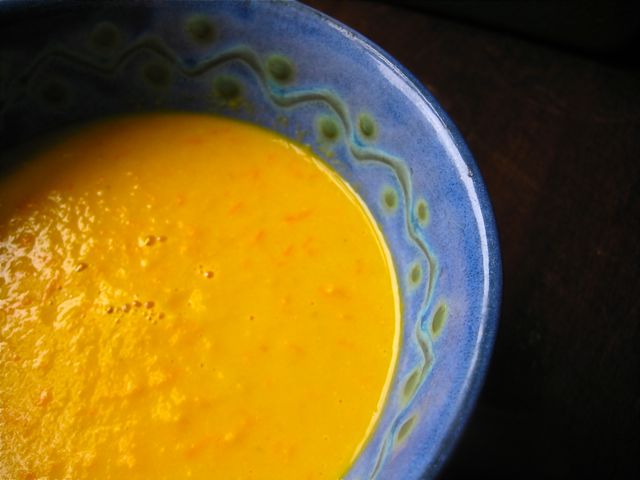 | ||||||||||||||||||||||
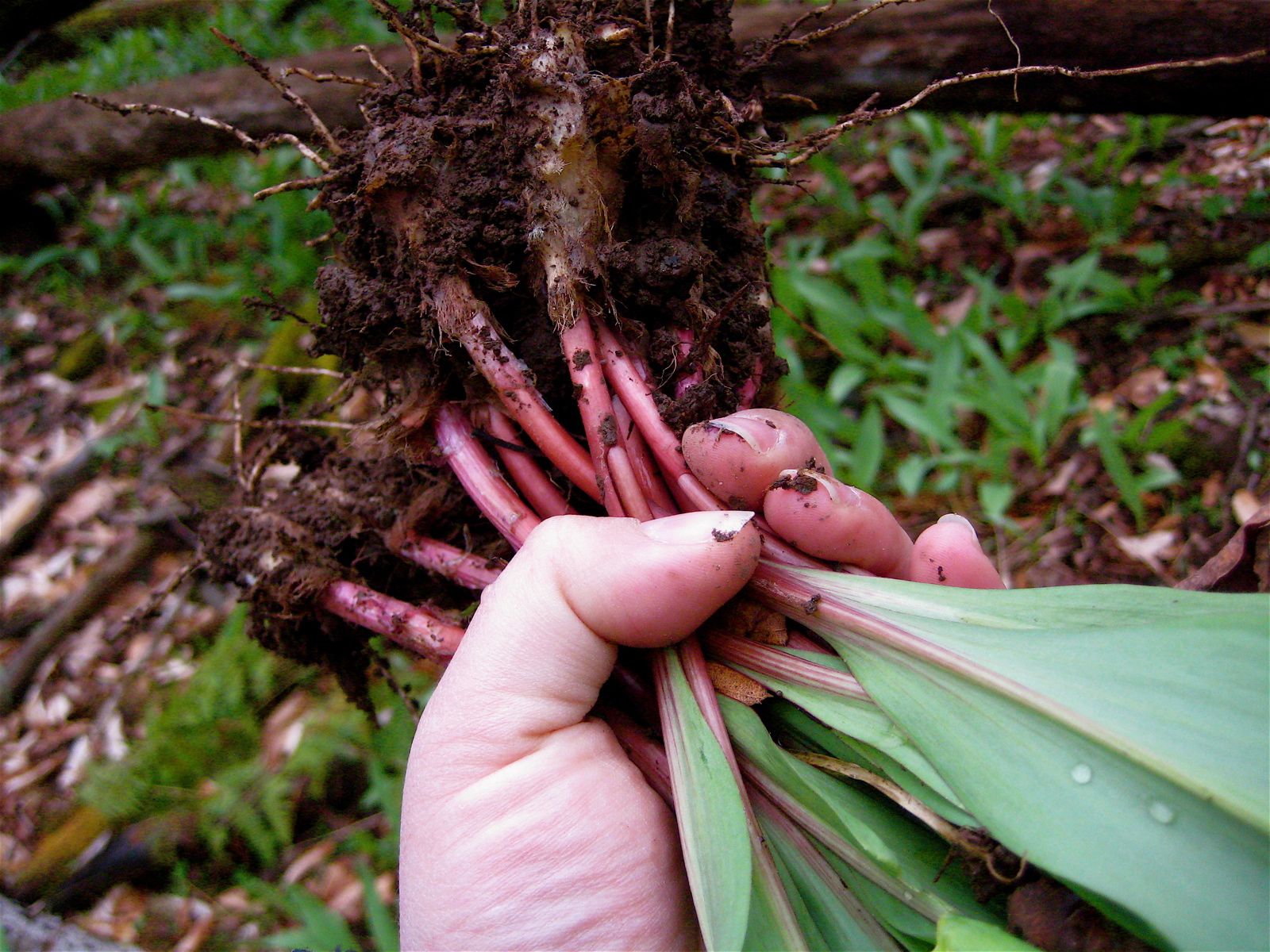 This past weekend friends who live near us upstate, on an area overrun with ramps, graciously invited us over for our second annual swap of all-we-can-pick ramps for a pick-up truck full of our "like gold" sheep manure for their garden. (So very cutting-edge-hipster-locavore. Then again, poop for weeds...) After a very muddy morning, we brought home two substantial garbage bags of ramps with their roots and soil intact, to transplant to our woods, and a very generous shopping bag of loose ramps to cook and eat. I got to work on a big batch of these slightly hot, slightly sweet, bright and tangy pickled ramps that night. I am now addicted, and looking forward to ice cold pickled ramp martinis later this summer. Oh, and picked ramps also go brilliantly with fish and roasted meats, on sandwiches, or alongside cheeses and charcuterie.
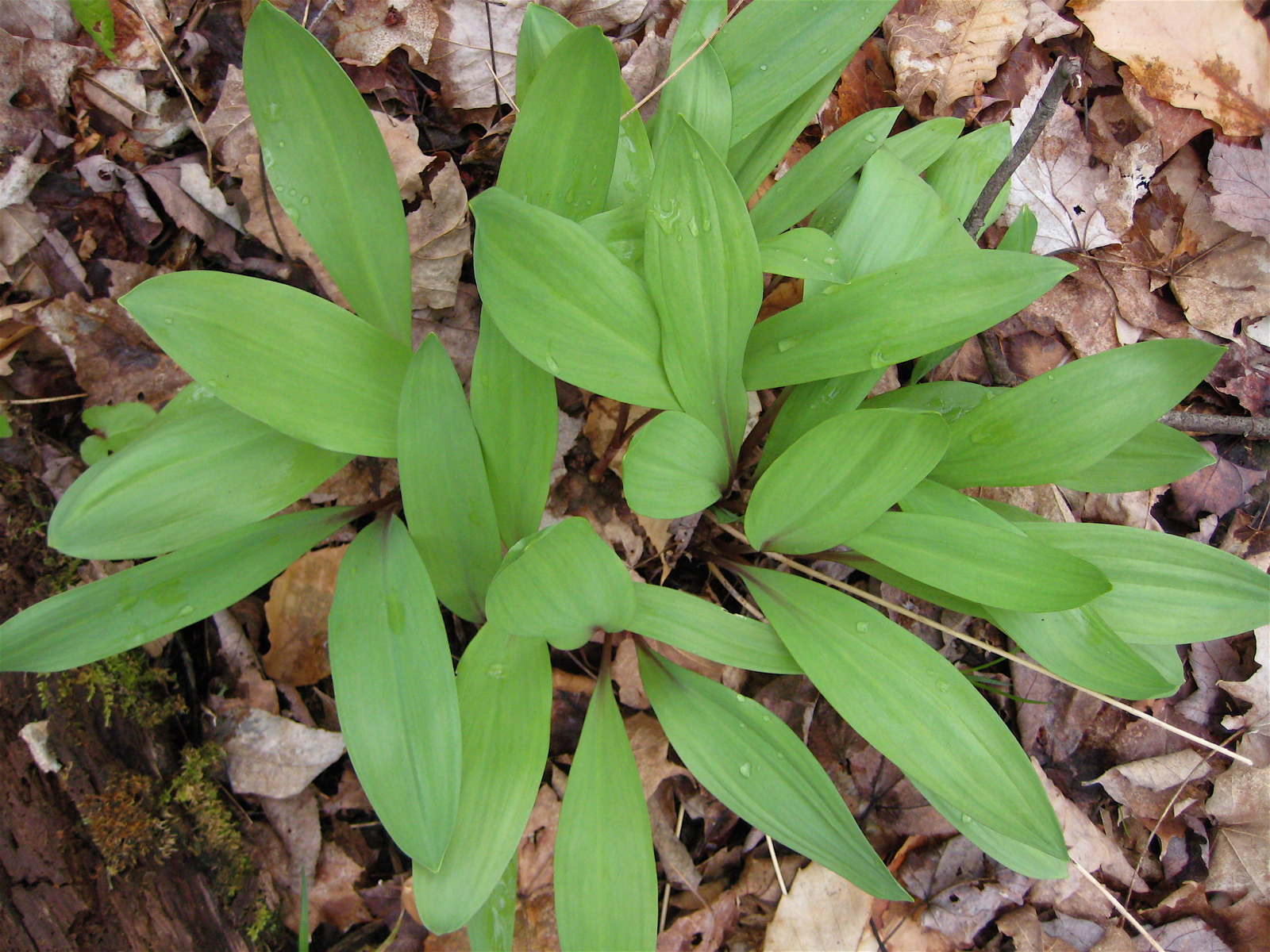 | ||||||||||||||||||||||
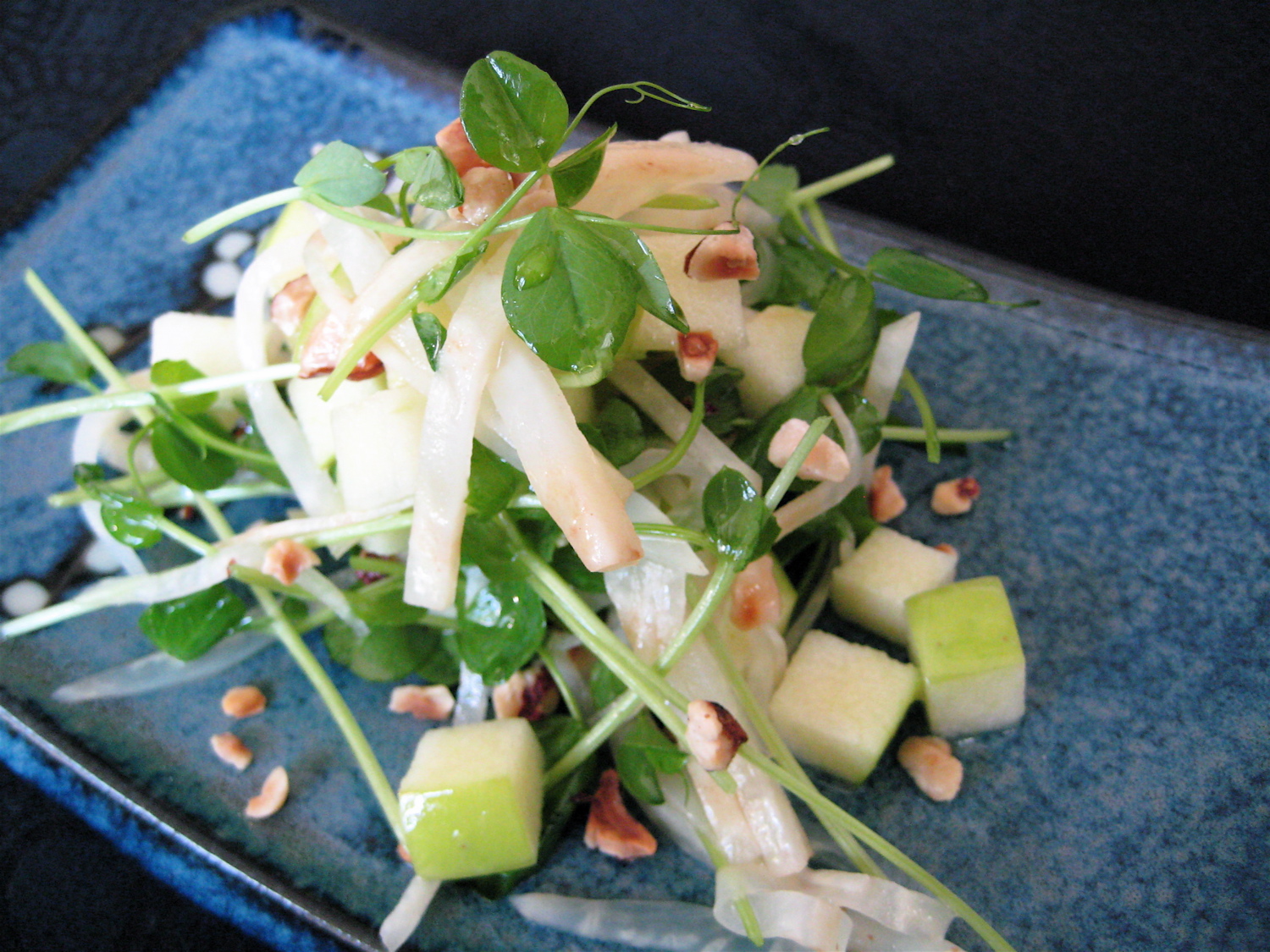 One of the toughest parts of eating almost exclusively locally in Upstate, NY, is the lack of bright, refreshing, crunchy, raw foods and salads in the colder months. We are overflowing in hearty carrot and squash soups, but there are definitely days I would kill for the snap of a thick slice of fresh cucumber. This week, particularly with the few amazing days of spring-promised sunshine we've had, I was already dreaming of getting started on my gardens, and craving some food of much warmer months. I did, however, gather at the farmer's market a collection of ingredients that came together for a great salad. When tested on my husband, the review was-- "Refreshing!". Perfect. 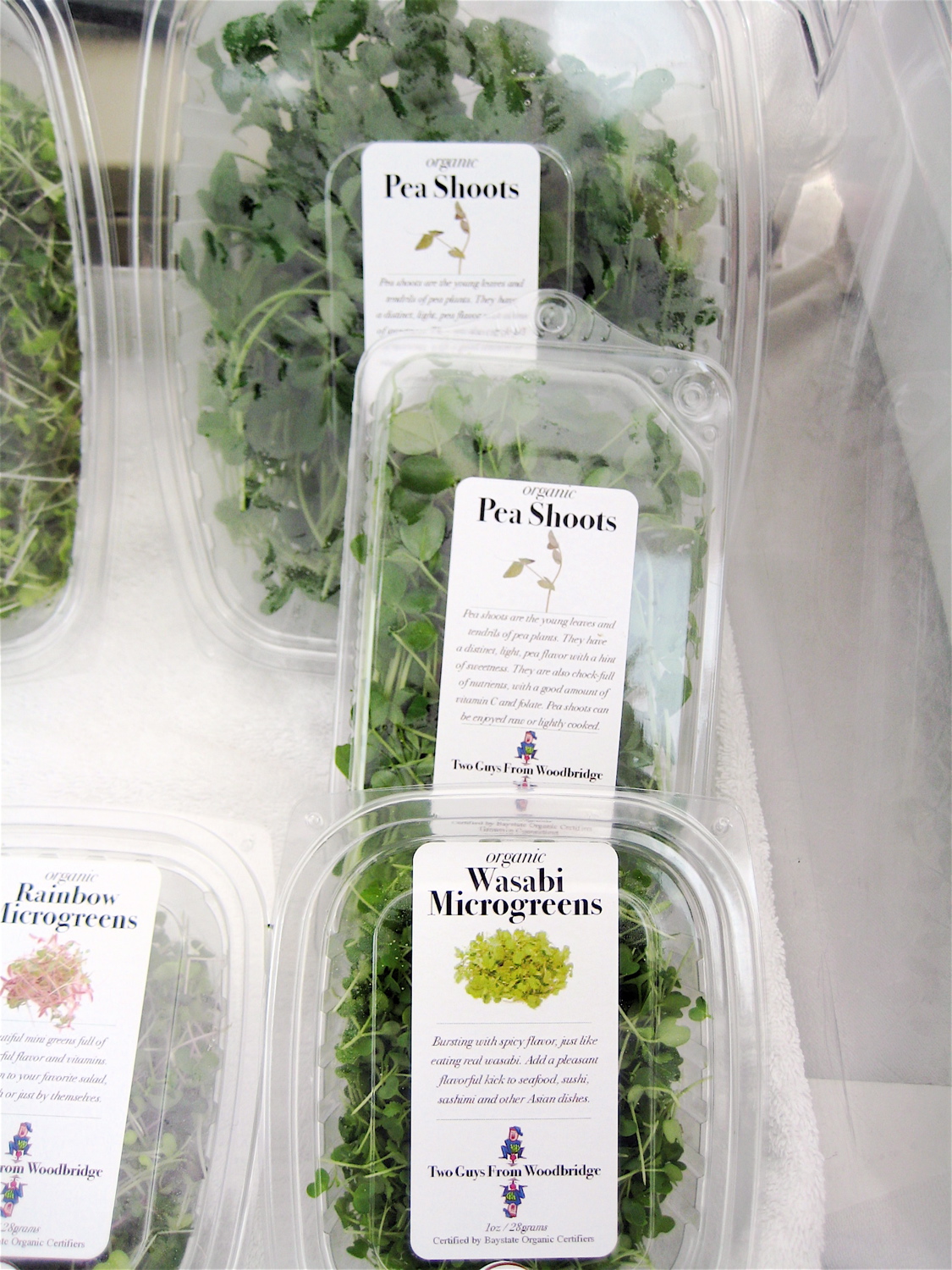 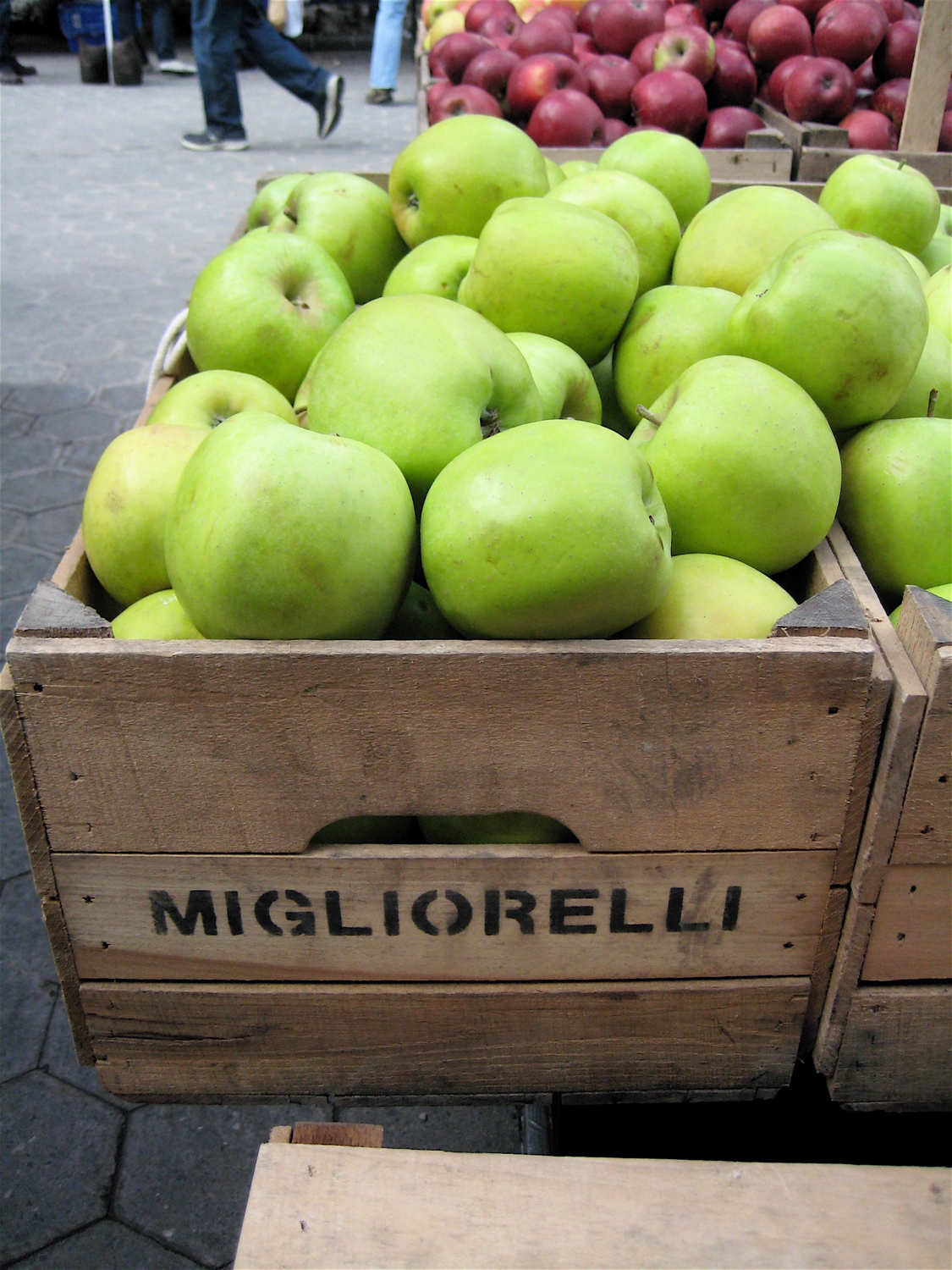 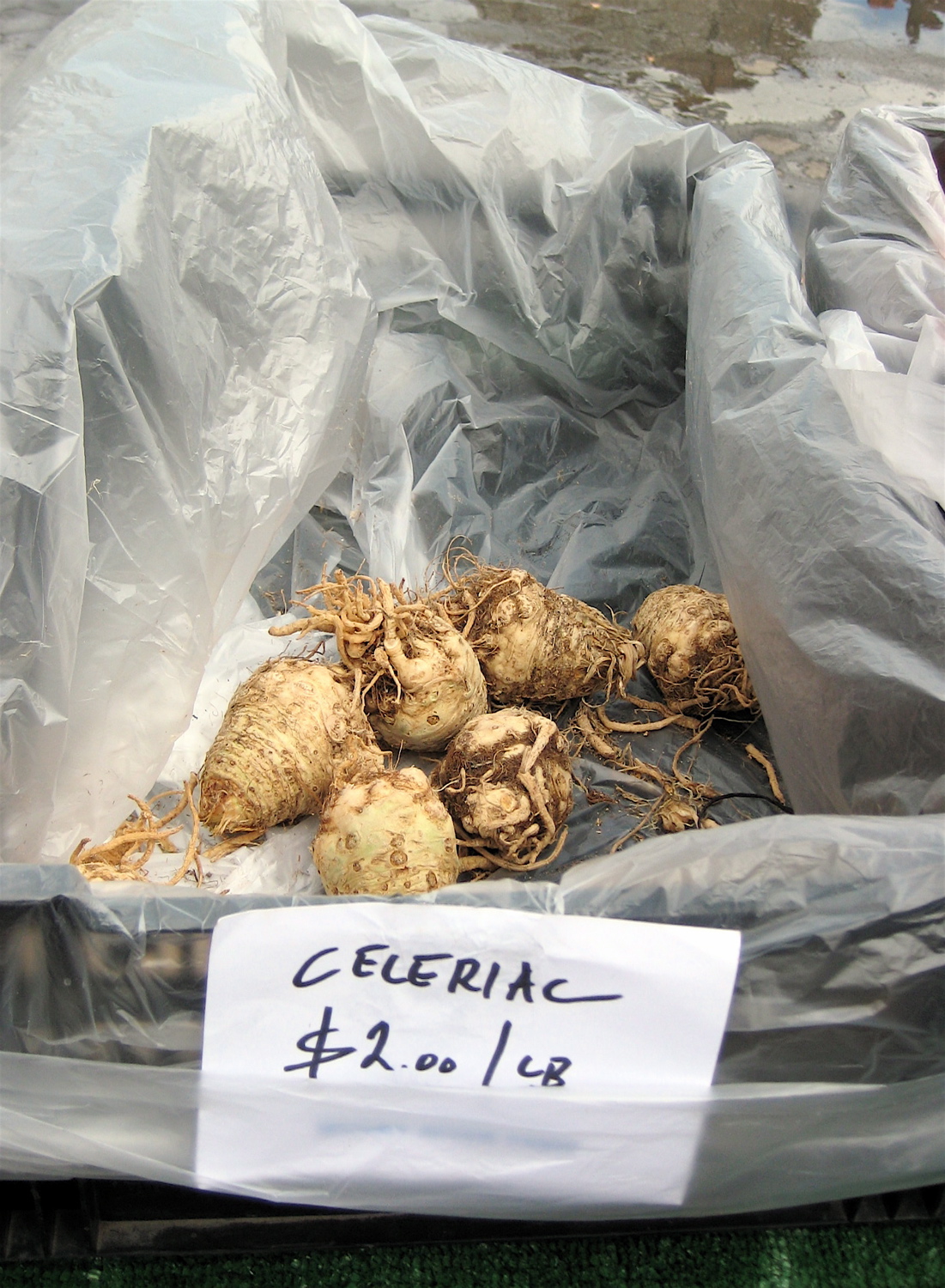 PEA SHOOT, CELERIAC, APPLE AND HAZELNUT SALAD by Catie Serves 4 2 large tart green apples (I used Mutzu apples from Migliorelli Farm) 1 medium celeriac (from Muddy River Farm in Goshen, NY) Medium handful of pea shoots, about 1 oz (from Two Guys from Woodbridge hydroponic farm, in Hamden, CT) 1/4 cup toasted and chopped hazelnuts for the dressing: 1 tsp apple cider vinegar 1 TBS hazelnut oil salt and pepper to taste. Cut the rough exterior off the celeriac, and cut the inner white part into thin matchsticks. Bring a pot of salted water to a boil. Have ready a bowl of ice water. When water is boiling, put in cut celeriac and blanch until al dente, about 30 seconds, depending on the size of the pieces. Immediately scoop out with slotted spoon and shock in ice water. Drain and dry. Cut apples in small cubes. Wash and dry pea shoots. Put cider vinegar in large bowl. Slowly add hazelnut oil in thin stream while whisking constantly. Season with salt and pepper. Add celeriac, apple, pea shoots, and hazelnuts to bowl. Toss with vinaigrette. Gently mound salad on a plate. Sprinkle top with a few more nuts. 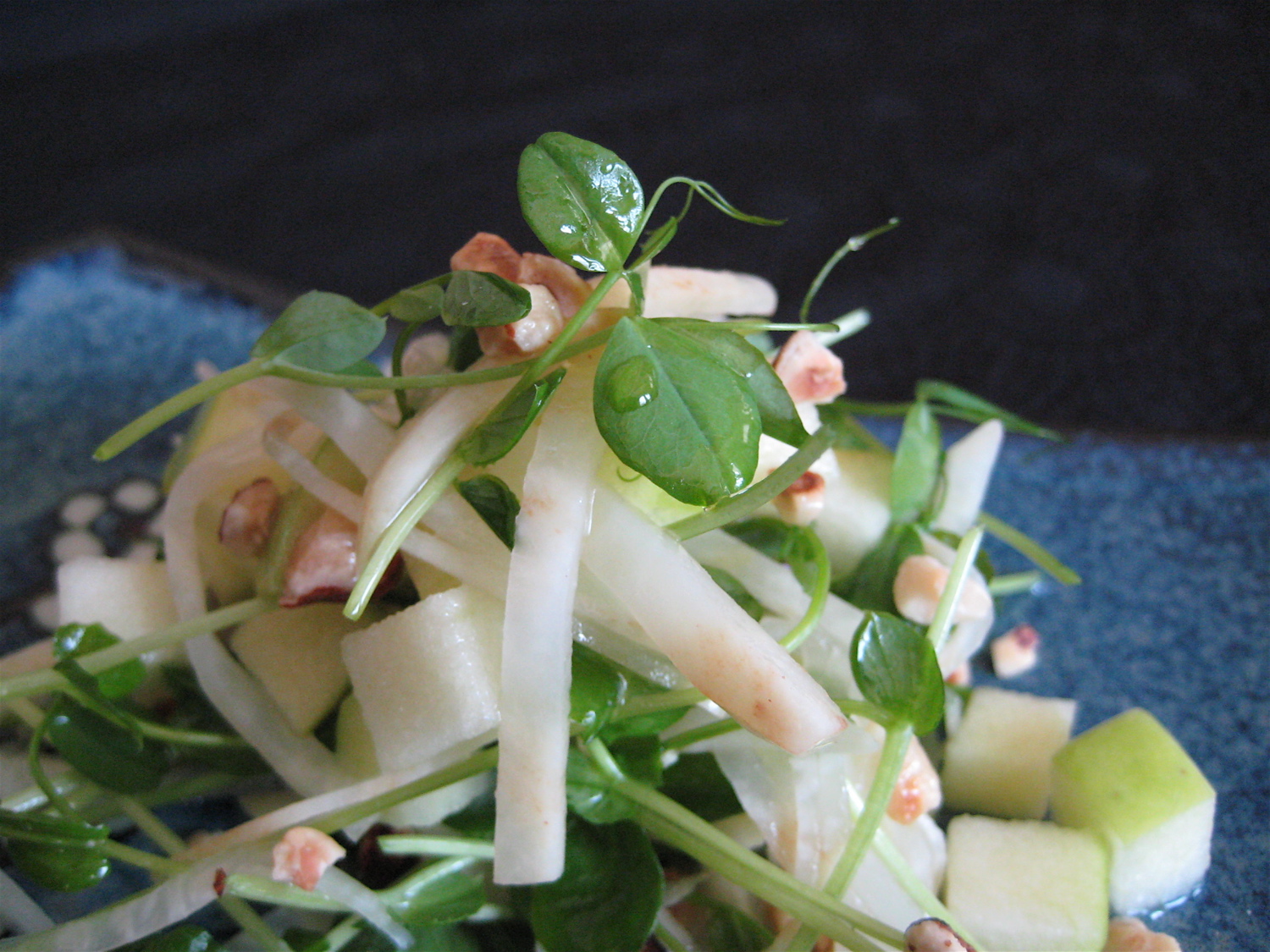 | ||||||||||||||||
|
{ welcome! }
 Catie Baumer Schwalb is a chef, food writer and photographer, who splits her life between the city and the country. Not too long ago Catie was a New York City based actress and playwright for more than a decade. She has her Master of Fine Arts from the National Theater Conservatory, and her Grand Diplôme in classic culinary arts from the French Culinary Institute in New York City.
... Read More ≫
Catie Baumer Schwalb is a chef, food writer and photographer, who splits her life between the city and the country. Not too long ago Catie was a New York City based actress and playwright for more than a decade. She has her Master of Fine Arts from the National Theater Conservatory, and her Grand Diplôme in classic culinary arts from the French Culinary Institute in New York City.
... Read More ≫{ get in touch }
{ what's new }
September 12, 2015
August 19, 2013
August 15, 2013
August 13, 2013
August 1, 2013
{ favorites }
{ archives }
Appetizers / Breads & Pastry / Breakfast / Cakes / Canning / Condiments / Dinner / DIY foods / Drinks / Fall / favorites / Grains / Holidays / Local / Noodles & Pasta / Pies & Tarts / Poultry / Salads / Seafood / Snacks / Soup / Spring / Summer / Sweets / Techniques / Vegetables / Vegetarian / Winter /
{ currently reading }
|



